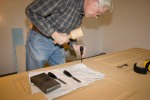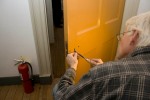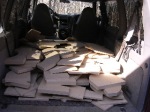RAC Update – 2/6/2006
General
Work progresses without any major complications and the warm weather has been an unexpected bonus.
Dining Room Fireplace (M-105)
Ray C. has started to remove the c. 1880 and c. 1901 infill from around the fireplace opening. Photographic evidence, as well as physical evidence, relates that there were at least three generations of mantels installed on the chimney breast (the 1797 Madison mantle, a fairly heavy Victorian mantel and a duPont era ornate marble mantel). Fortunately most of the alterations for the later mantels involved infilling around original 1797 material. As a result, it appears that the rough dimensions for the facing of the fireplace can be recovered. C. 1797 wrought iron cramps have also been found in situ that, according to Ray C., were probably used to hold a facing made from either sandstone or limestone. The cramps will also give us, once they have been unbent, a fairly exact measurement for how far the facing projected past the chimney breast (or if it projected at all).
Drawing Room Mantel (M-108)
The St. Bee’s sandstone for the dutchmen has arrived and Ray C. should begin to carve the replacement pieces soon.
Dolly’s Chamber (M-100)
The floor has been uncovered and the final remnants of the glue are being removed. I also spoke too soon when I said the floorboards in the chamber were thinner then the boards used to floor the Nelly Chamber. It appears that thinner boards were just used near the northern wall (which was the part of the floor that was cleaned first). However, the Dinsmore accounts still show small differences between the rooms and these will still be investigated and analyzed. We have also yet to look for evidence of bookshelves on the floors, but we will as soon as the last of the glue is removed.
Dolly’s Kitchen (M-001)
The archaeologists are finished in Dolly’s kitchen. More evidence of herringbone paving was found, but, again, very little cultural material was recovered.
Roof
Shingling continues and Peter P. is slowly marching his way around the house installing the lower rows of shingles. Work is also progressing on the wing roofs and the sheet metal for the guttering has been installed.
Colonnade
The first level of subfloor has been installed as have the outriggers and blocking for the entablature.
Portico
The engaged brick piers have been reconstructed for the Portico deck.
Masonry
Miscellaneous repointing and repairs are being made to the exterior and interior. Specifically, work is being done to the south wall of the 1760 wine cellar (M-004), the 1760 Passage (M-109) and the c. 1810 doorway between the Drawing Room (M-108) and the 1760 Passage (M-109).
On-Site Interiors Meeting
Susan has instituted a twice monthly on-site interiors meeting. At the last meeting we discussed where, and if, to leave windows in the finished fabric to demonstrate the architectural fabric. No decision has been made, but several areas that demonstrate clear evidence of the mansion’s evolution were highlighted as well as the desire to leave one whole room unrestored. A consensus to use reproduction artworks in the Drawing Room (M-108), instead of trying to purchase or loan originals, was also reached.









 Posted by montpelierrestoration
Posted by montpelierrestoration